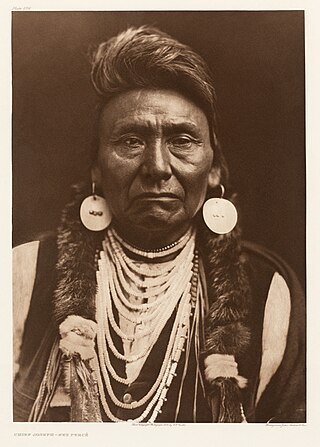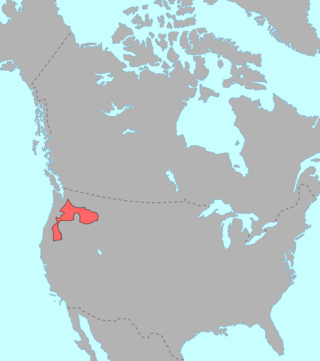Related Research Articles

In grammar, the ergative case is the grammatical case that identifies a nominal phrase as the agent of a transitive verb in ergative–absolutive languages.
A grammatical case is a category of nouns and noun modifiers that corresponds to one or more potential grammatical functions for a nominal group in a wording. In various languages, nominal groups consisting of a noun and its modifiers belong to one of a few such categories. For instance, in English, one says I see them and they see me: the nominative pronouns I/they represent the perceiver, and the accusative pronouns me/them represent the phenomenon perceived. Here, nominative and accusative are cases, that is, categories of pronouns corresponding to the functions they have in representation.

The Nez Perce are an Indigenous people of the Plateau who still live on a fraction of the lands on the southeastern Columbia River Plateau in the Pacific Northwest. This region has been occupied for at least 11,500 years.

Nez Perce CountyNEZZ-purse; is a county located in the U.S. state of Idaho. As of the 2020 census, the population was 42,090. The county seat is Lewiston. The county is named after the Native American Nez Perce tribe. Nez Perce County is part of the Lewiston, Idaho–WA Metropolitan Statistical Area.

The Appaloosa is an American horse breed best known for its colorful spotted coat pattern. There is a wide range of body types within the breed, stemming from the influence of multiple breeds of horses throughout its history. Each horse's color pattern is genetically the result of various spotting patterns overlaid on top of one of several recognized base coat colors. The color pattern of the Appaloosa is of interest to those who study equine coat color genetics, as it and several other physical characteristics are linked to the leopard complex mutation (LP). Appaloosas are prone to develop equine recurrent uveitis and congenital stationary night blindness; the latter has been linked to the leopard complex.

Lewis County is a county located in the north central region of the U.S. state of Idaho. As of the 2020 census, the population was 3,533, making it the fourth-least populous county in Idaho. The county seat is Nezperce, and Kamiah is the largest city. Partitioned from Nez Perce County and established in 1911, it was named after the explorer Meriwether Lewis. Most of the county is within the Nez Perce Indian Reservation, though Native Americans comprise less than 6% of the county population. Similar to the opening of lands in Oklahoma, the U.S. government opened the reservation for white settlement in November 1895. The proclamation had been signed less than two weeks earlier by President Cleveland.

Hin-mah-too-yah-lat-kekt, popularly known as Chief Joseph, Young Joseph, or Joseph the Younger, was a leader of the wal-lam-wat-kain (Wallowa) band of Nez Perce, a Native American tribe of the interior Pacific Northwest region of the United States, in the latter half of the 19th century. He succeeded his father Tuekakas in the early 1870s.
In linguistics, morphosyntactic alignment is the grammatical relationship between arguments—specifically, between the two arguments of transitive verbs like the dog chased the cat, and the single argument of intransitive verbs like the cat ran away. English has a subject, which merges the more active argument of transitive verbs with the argument of intransitive verbs, leaving the object distinct; other languages may have different strategies, or, rarely, make no distinction at all. Distinctions may be made morphologically, syntactically, or both.

The Nez Perce War was an armed conflict in 1877 in the Western United States that pitted several bands of the Nez Perce tribe of Native Americans and their allies, a small band of the Palouse tribe led by Red Echo (Hahtalekin) and Bald Head, against the United States Army. Fought between June and October, the conflict stemmed from the refusal of several bands of the Nez Perce, dubbed "non-treaty Indians," to give up their ancestral lands in the Pacific Northwest and move to an Indian reservation in Idaho Territory. This forced removal was in violation of the 1855 Treaty of Walla Walla, which granted the tribe 7.5 million acres of their ancestral lands and the right to hunt and fish on lands ceded to the U.S. government.

The Nez Perce National Historical Park is a United States National Historical Park comprising 38 sites located across the states of Idaho, Montana, Oregon, and Washington, which include traditional aboriginal lands of the Nez Perce people. The sites are strongly associated with the resistance of Chief Joseph and his band, who in June 1877 migrated from Oregon in an attempt to reach freedom in Canada and avoid being forced on to a reservation. They were pursued by U.S. Army cavalry forces and fought numerous skirmishes against them during the so-called Nez Perce War, which eventually ended with Chief Joseph's surrender in the Montana Territory.

The Nez Perce National Forest is a 4,000,000-acre (16,000 km2) United States National Forest located in west-central Idaho. The forest is bounded on the east by the state of Montana, on the north by the Clearwater National Forest, on the west by a portion of the Wallowa–Whitman National Forest and on the south by the Payette National Forest.

Clearwater National Forest with headquarters on the Nez Perce Reservation at Kamiah is located in North Central Idaho in the northwestern United States. The forest is bounded on the east by the state of Montana, on the north by the Idaho Panhandle National Forest, and on the south and west by the Nez Perce National Forest and Palouse Prairie.
In linguistic typology, tripartite alignment is a type of morphosyntactic alignment in which the main argument ('subject') of an intransitive verb, the agent argument ('subject') of a transitive verb, and the patient argument of a transitive verb are each treated distinctly in the grammatical system of a language. This is in contrast with nominative-accusative and ergative-absolutive alignment languages, in which the argument of an intransitive verb patterns with either the agent argument of the transitive or with the patient argument of the transitive. Thus, whereas in English, "she" in "she runs" patterns with "she" in "she finds it", and an ergative language would pattern "she" in "she runs" with "her" in "he likes her", a tripartite language would treat the "she" in "she runs" as morphologically and/or syntactically distinct from either argument in "he likes her".

The Battle of the Big Hole was fought in Montana Territory, August 9–10, 1877, between the United States Army and the Nez Perce tribe of Native Americans during the Nez Perce War. Both sides suffered heavy casualties. The Nez Perce withdrew in good order from the battlefield and continued their long fighting retreat that would result in their attempt to reach Canada and asylum.

Big Hole National Battlefield preserves a battlefield in the western United States, located in Beaverhead County, Montana. In 1877, the Nez Perce fought a delaying action against the U.S. Army's 7th Infantry Regiment here on August 9 and 10, during their failed attempt to escape to Canada. This action, the Battle of the Big Hole, was the largest battle fought between the Nez Perce and U.S. Government forces in the five-month conflict known as the Nez Perce War.

Nez Perce, also spelled Nez Percé or called nimipuutímt, is a Sahaptian language related to the several dialects of Sahaptin. Nez Perce comes from the French phrase nez percé, "pierced nose"; however, Nez Perce, who call themselves nimíipuu, meaning "the people", did not pierce their noses. This misnomer may have occurred as a result of confusion on the part of the French, as it was surrounding tribes who did so.
The Nez Perce (Nee-Me-Poo) National Historic Trail follows the route taken by a large group of people of the Nez Perce tribe in 1877 to avoid being forced onto a reservation. The 1,170-mile (1,883 km) trail was created in 1986 as part of the National Trails System Act and is managed by the U.S. Forest Service. The trail passes through portions of the U.S. states of Oregon, Idaho, Wyoming, and Montana. It connects sites across these states to commemorate significant events of the Nez Perce War, which took place between June and October 1877 as several bands of Nez Perce tried to evade the U.S. Cavalry and escape to Canada. The sites are among the 38 that are collectively managed by the U.S. National Park Service as part of the Nez Perce National Historical Park, though some sites are individually managed by local or state-affiliated organizations.

Fort Nez Percés, later known as (Old) Fort Walla Walla, was a fortified fur trading post on the Columbia River on the territory of modern-day Wallula, Washington. Despite being named after the Nez Perce people, the fort was in the traditional lands of the Walla Walla. Founded in 1818 by the North-West Company, after 1821 it was run by the Hudson's Bay Company until its closure in 1857.
Sahaptin, also called Ichishkiin, is one of the two-language Sahaptian branch of the Plateau Penutian family spoken in a section of the northwestern plateau along the Columbia River and its tributaries in southern Washington, northern Oregon, and southwestern Idaho, in the United States; the other language is Nez Perce (Niimi'ipuutímt).
Hindi-Urdu, also known as Hindustani, has three noun cases and five pronoun cases. The oblique case in pronouns has three subdivisions: Regular, Ergative, and Genitive. There are eight case-marking postpositions in Hindi and out of those eight the ones which end in the vowel -ā also decline according to number, gender, and case.
References
- ↑ Aldridge, Edith (2017-08-10). Coon, Jessica; Massam, Diane; Travis, Lisa Demena (eds.). Intransitivity and the Development of Ergative Alignment. Vol. 1. Oxford University Press. doi:10.1093/oxfordhb/9780198739371.013.21.
- ↑ Rude, Noel (1991). "On the Origin of the Nez Perce Ergative NP Suffix". International Journal of American Linguistics. 57 (1): 24–50. ISSN 0020-7071.